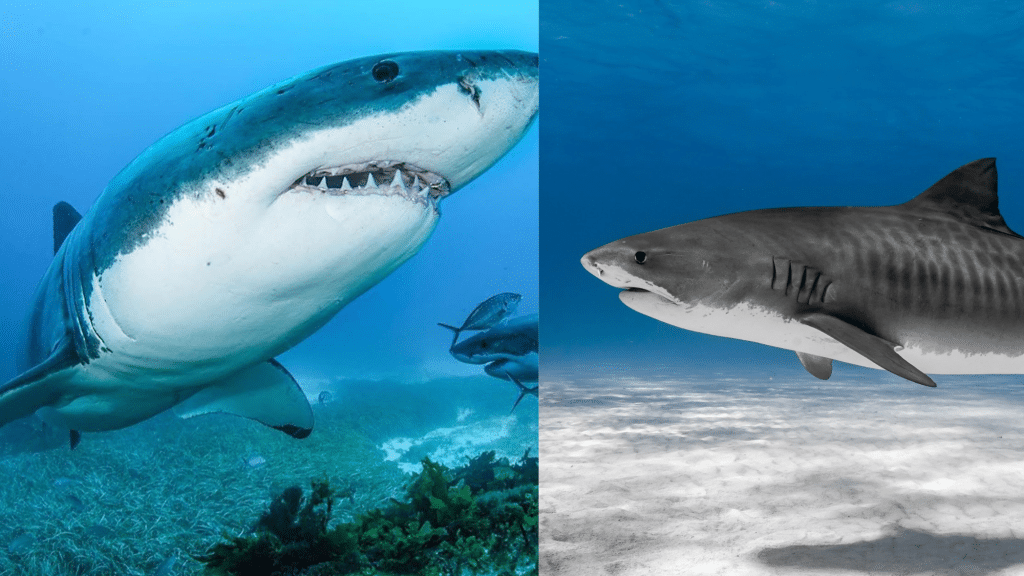Which shark is cooler, the tiger shark or the great white shark?
No doubt, both are powerful ocean predators, but they differ significantly in their appearance, hunting methods, and lifestyle.
In this fun face-off, we will break down what makes each one special, from where they swim to how they catch their prey.
If you are curious about sharks or wondering which one you might spot near the beach, scroll down!
Tiger Shark Vs. Great White – Spot the Difference
Below are the various aspects listed to give you a clear view of the basic differences between the tiger shark and the great white.
1. Physical Characteristics
When comparing size, the Great White Shark is the larger of the two, typically growing between 12 to 20feet long and weighing 1,500 to 2,400pounds.
In contrast, the Tiger Shark usually ranges from 10 to 14 feet in length and weighs between 850 to 1,400 pounds.
| Feature | Great White Shark | Tiger Shark |
|---|---|---|
| Body Shape | Torpedo-shaped body with a pointed snout | Blunter, wider head |
| Teeth | Triangular, serrated teeth for tearing prey | Notched teeth for cutting through shells/bones |
| Color | Gray upper body, white underbelly | Greenish-gray or bluish, excellent camouflage |
| Gill Slits | Five gill slits on each side | Similar, but with slight differences in anatomy |
| Tail | Crescent-shaped, providing a powerful swimming ability | Stockier build, powerful swimmer, but less sleek |
| Distinctive Markings | No specific markings, solid color | Dark stripes that fade as they age |
2. Habitat and Distribution
Great White Sharks
- Prefer calmer, temperate coastal waters.
- It is found mainly around the coasts of Australia, South Africa, California, Mexico, and the Mediterranean.
- Usually, they stick to waters above continental shelves rather than the deep open ocean.
- Seasonally, they migrate to follow food sources and for breeding.
Tiger Sharks
- Love warm, tropical, and subtropical waters.
- Common around Pacific islands, the Caribbean, Australia, and along the eastern coast of North America.
- Comfortable in both deep ocean waters and shallow coastal areas.
- More tolerant of different water conditions than many other shark species
3. Hunting Behavior
Great whites are ambush predators famous for their powerful breach attacks, in which they rocket upward to surprise their prey, such as seals. They rely on speed and surprise to succeed.
Tiger sharks are more opportunistic, earning their nickname as “garbage cans of the sea” by eating almost anything.
They prefer a patient hunting style, are often active at night, and are known for their ability to crack turtle shells with their specialized teeth.
Both species have developed hunting techniques that enable them to become top predators in their respective environments.
4. Lifespan and Reproduction
Despite their fearsome reputations as ocean predators, both shark species share a surprising weakness.
They reproduce slowly and take years to reach sexual maturity, making their populations especially fragile when faced with environmental or human pressures.
| Aspect | Great White Shark | Tiger Shark |
|---|---|---|
| Lifespan | Can live for 70+ years | Typically lives for 25-30 years |
| Maturation | Takes 15-20 years to reach breeding age | Reaches breeding age in 7-10 years |
| Reproduction | Ovoviviparous, carrying 2-10 pups for 12-18 months | Ovoviviparous, larger litters of 10-80 pups with a 9-month gestation |
| Pup Size at Birth | Pups measure 4-5 feet | Pups’ size varies, typically smaller at birth |
Which is More Dangerous to Humans?
Both great white and tiger sharks are among the species most often involved in unprovoked attacks, but neither really targets humans.
Tiger sharks are responsible for more attacks than great whites in some areas, like Hawaii and the Caribbean. Great whites, on the other hand, usually mistake surfers for seals, leading to “bite-and-release” incidents.
Surprisingly, you are more likely to be hurt by a vending machine or toilet than by a shark. These sharks don’t actively hunt humans.
Conclusion
So, which shark wins in the end?
The truth is, both tiger sharks and great whites are fabulous in their own ways.
Great whites are like the specialized sharks of the world, with their seal-hunting skills, while tiger sharks are the ultimate survivors.
So, whether you encounter a great white or a tiger shark, remember they both play an important role in keeping the ocean ecosystem balanced.




















